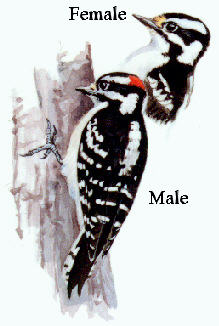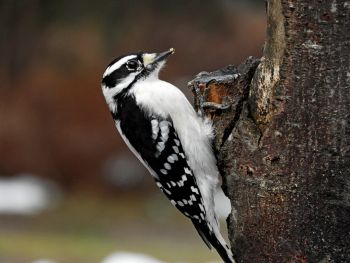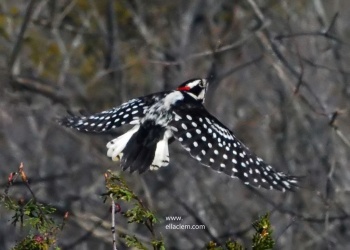(→External Links: Multiple GSearches combined) |
|||
| (34 intermediate revisions by 14 users not shown) | |||
| Line 1: | Line 1: | ||
| − | ;Picoides pubescens | + | [[Image:Downy_WoodpeckerCurtmorgan.jpg|thumb|450px|right|Photo © by {{user|CurtMorgan|Curt Morgan}}<br />Colonie, [[New York]], [[USA]], 31 March 2012]] |
| − | [[ | + | ;[[:Category:Dryobates|Dryobates]] pubescens |
| − | == | + | ''Picoides pubescens'' |
| + | ==Identification== | ||
| + | [[File:Downy_Woodpecker_Female_WNDR.jpg|thumb|350px|right|Female<br />Photo © by {{user|wonderview|wonderview}}<br />[[Nova Scotia]], [[Canada]], 4 February 2021]] | ||
| + | Length: 15–17 cm (6-6¾ inches) (smallest woodpecker in [[North America]].)<br /> | ||
| + | *Very small black and white woodpecker | ||
| + | *Very short bill | ||
| + | *Mostly black head set off by broad white [[Topography#Heads|supercilium]] and lower border to [[Topography#Heads|auriculars]] | ||
| + | *Black nape | ||
| + | *White back | ||
| + | *Black wings with white spotting on [[Topography#General Anatomy|coverts]] and flight feathers | ||
| + | *White underparts | ||
| + | *Black rump | ||
| + | *Black tail with white outer tail feathers barred with black<br /> | ||
| + | '''Adult male''': Red spot on nape | ||
| + | ====Similar species==== | ||
| + | [[Image:Downy_Woodpecker.jpg|thumb|right|Artwork © by {{user|fishercl|fishercl}}]] | ||
| + | [[Hairy Woodpecker]] has a proportionately larger bill than [[Downy Woodpecker]], that is about the same length as the head.<br/> | ||
| + | Downy Woodpecker has a much smaller, stubbier bill. Hairy Woodpecker lacks dark markings on its outer tail feathers that the Downy has. (This field mark is less useful in the Northwest where darker races of both species exist and these marks are usually present). Hairy usually has a black dividing line at the rear through the red (male) or white area just below the crown, while 99% of Downy Woodpeckers lack that dividing line<sup>[[#References|[2]]]</sup>. | ||
| − | + | ==Distribution== | |
| − | + | [[Image:20110629MaleDowny2 1.jpg|thumb|350px|right|Young Male<br />Photo © by {{user|Al_in_Virginia|Al_in_Virginia}}<br />Quinton, [[Virginia]], [[USA]], 29 June 2011]] | |
| − | + | Resident from [[Alaska]] across [[Canada]], south throughout [[United States]] except Southwest. Can also be found east of [[Newfoundland]] and [[Labrador]], on the islands of Saint-Pierre and Miquelon. | |
| − | + | ==Taxonomy== | |
| − | + | [[Image:Downyflym filtered.jpg|thumb|350px|right|Photo © by {{user|Deerbird|Deerbird}}<br />[[Kentucky]], 8 January 2017]] | |
| − | + | Placed in genus ''[[:Category:Dryobates|Dryobates]]'' by Gill and Donsker. | |
| − | + | ====Subspecies==== | |
| − | + | [[File:Downy_Woodpecker_Male_SJ.jpg|thumb|350px|right|Male in nest cavity <br />Photo © by {{user|Stanley+Jones|Stanley Jones}}<br />Brazos County, [[Texas]], [[USA]], 2 April 2021]] | |
| − | + | There are 6 subspecies<sup>[[#References|[1]]]</sup>:<br /> | |
| − | + | '''Eastern''' | |
| + | *''D. p. pubescens'': | ||
| + | :*[[Kansas]] to [[North Carolina]], south to eastern [[Texas]] and [[Florida]] | ||
| + | *''D. p. medianus'': | ||
| + | :*Central [[Alaska]] to [[Newfoundland]] and central [[US]] (east of Rocky Mountains)<br /> | ||
| + | '''Rocky Mountains''' | ||
| + | *''D. p. leucurus'': | ||
| + | :*Rocky Mountains (south-eastern [[Alaska]] to south-western [[US]]) | ||
| + | *''D. p. glacialis'': | ||
| + | :*Coastal south-eastern [[Alaska]]<br /> | ||
| + | '''Pacific''' | ||
| + | *''D. p. gairdnerii'': | ||
| + | :*Coastal western [[British Columbia]] to north-western [[California]] | ||
| + | *''D. p. turati'': | ||
| + | :*Interior Washington, [[Oregon]] and [[California]] | ||
| + | ==Habitat== | ||
| + | Their breeding habitat is forested areas, mainly deciduous, across most of North America to Central America. | ||
| − | + | The Downy is a familiar bird in its range, especially in winter, when many move into the suburbs and feed on suet at bird feeders. It is often seen in the mixed flocks of chickadees, nuthatches, creepers, and kinglets that gather in the woods during migration and winter. | |
| + | ==Behaviour== | ||
| + | ====Diet==== | ||
| + | As with other woodpeckers, the male is larger than the female and chisels deep into wood with its longer, stronger bill, whereas the female pries under the bark with her shorter bill. Thus a pair is able to share the food resources without competing with one another. | ||
| + | ====Breeding==== | ||
| + | They nest in a tree cavity, excavated by the nesting pair in a dead tree or limb. | ||
| + | ====Vocalisation==== | ||
| + | A quiet ''pik'' or a descending rattle. Both sexes drum on trees to claim territories, attract mates, and signal readiness for mating. The drumming is very rapid and steady, almost rendering into a single uninterrupted sound. | ||
| − | + | {{ Audio|DownlyWoodpeckerMVI 1959.mp3 }} | |
| + | [[Media:DownlyWoodpeckerMVI 1959.mp3|Listen to drumming sounds])<br /> | ||
| + | Recording © by {{user|jmorlan|Joseph Morlan}}<br /> | ||
| + | Moss Beach, [[California]], 18 April 2020 | ||
| − | == | + | ====Movements==== |
| − | |||
| − | |||
| − | == | + | Resident in most of range. Northern and montane populations are partially migratory or disperse over longer distances. |
| − | + | ==References== | |
| − | + | #{{Ref-Clements6thAug19}}#[http://www.sibleyguides.com/2011/03/another-clue-for-identifying-downy-and-hairy-woodpeckers/ Another clue for identifying Downy and Hairy Woodpeckers - Sibley Guides] | |
| + | #Jackson, J. A. and H. R. Ouellet (2020). Downy Woodpecker (''Dryobates pubescens''), version 1.0. In Birds of the World (P. G. Rodewald, Editor). Cornell Lab of Ornithology, Ithaca, NY, USA. https://doi.org/10.2173/bow.dowwoo.01 | ||
| + | #Winkler, H. & Christie, D.A. (2020). Downy Woodpecker (''Dryobates pubescens''). In: del Hoyo, J., Elliott, A., Sargatal, J., Christie, D.A. & de Juana, E. (eds.). Handbook of the Birds of the World Alive. Lynx Edicions, Barcelona. (retrieved from https://www.hbw.com/node/56234 on 1 May 2020). | ||
| + | #Cornell Lab of Ornithology. 2019. All About Birds. Cornell Lab of Ornithology, Ithaca, New York. https://www.allaboutbirds.org Accessed on 1 May 2020 | ||
| + | {{ref}} | ||
| − | == | + | ==External Links== |
| − | + | {{GSearch|"Dryobates pubescens" {{!}} "Picoides pubescens" {{!}} "Downy Woodpecker"}} | |
| − | < | + | {{GS-checked}}1 |
| + | <br /> | ||
| + | <br /> | ||
| − | + | [[Category:Birds]] [[Category:Dryobates]] | |
| − | |||
| − | |||
| − | |||
| − | |||
| − | |||
| − | |||
| − | |||
| − | |||
| − | |||
| − | [[Category: | ||
Latest revision as of 22:21, 21 February 2023
- Dryobates pubescens
Picoides pubescens
Identification
Length: 15–17 cm (6-6¾ inches) (smallest woodpecker in North America.)
- Very small black and white woodpecker
- Very short bill
- Mostly black head set off by broad white supercilium and lower border to auriculars
- Black nape
- White back
- Black wings with white spotting on coverts and flight feathers
- White underparts
- Black rump
- Black tail with white outer tail feathers barred with black
Adult male: Red spot on nape
Similar species

Hairy Woodpecker has a proportionately larger bill than Downy Woodpecker, that is about the same length as the head.
Downy Woodpecker has a much smaller, stubbier bill. Hairy Woodpecker lacks dark markings on its outer tail feathers that the Downy has. (This field mark is less useful in the Northwest where darker races of both species exist and these marks are usually present). Hairy usually has a black dividing line at the rear through the red (male) or white area just below the crown, while 99% of Downy Woodpeckers lack that dividing line[2].
Distribution
Resident from Alaska across Canada, south throughout United States except Southwest. Can also be found east of Newfoundland and Labrador, on the islands of Saint-Pierre and Miquelon.
Taxonomy
Placed in genus Dryobates by Gill and Donsker.
Subspecies
There are 6 subspecies[1]:
Eastern
- D. p. pubescens:
- Kansas to North Carolina, south to eastern Texas and Florida
- D. p. medianus:
- Central Alaska to Newfoundland and central US (east of Rocky Mountains)
- Central Alaska to Newfoundland and central US (east of Rocky Mountains)
Rocky Mountains
- D. p. leucurus:
- D. p. glacialis:
- Coastal south-eastern Alaska
- Coastal south-eastern Alaska
Pacific
- D. p. gairdnerii:
- Coastal western British Columbia to north-western California
- D. p. turati:
- Interior Washington, Oregon and California
Habitat
Their breeding habitat is forested areas, mainly deciduous, across most of North America to Central America.
The Downy is a familiar bird in its range, especially in winter, when many move into the suburbs and feed on suet at bird feeders. It is often seen in the mixed flocks of chickadees, nuthatches, creepers, and kinglets that gather in the woods during migration and winter.
Behaviour
Diet
As with other woodpeckers, the male is larger than the female and chisels deep into wood with its longer, stronger bill, whereas the female pries under the bark with her shorter bill. Thus a pair is able to share the food resources without competing with one another.
Breeding
They nest in a tree cavity, excavated by the nesting pair in a dead tree or limb.
Vocalisation
A quiet pik or a descending rattle. Both sexes drum on trees to claim territories, attract mates, and signal readiness for mating. The drumming is very rapid and steady, almost rendering into a single uninterrupted sound.
[[Media:DownlyWoodpeckerMVI 1959.mp3|Listen to drumming sounds])
Recording © by Joseph Morlan
Moss Beach, California, 18 April 2020
Movements
Resident in most of range. Northern and montane populations are partially migratory or disperse over longer distances.
References
- Clements, J. F., T. S. Schulenberg, M. J. Iliff, S. M. Billerman, T. A. Fredericks, B. L. Sullivan, and C. L. Wood. 2019. The eBird/Clements Checklist of Birds of the World: v2019. Downloaded from http://www.birds.cornell.edu/clementschecklist/download/
- Another clue for identifying Downy and Hairy Woodpeckers - Sibley Guides
- Jackson, J. A. and H. R. Ouellet (2020). Downy Woodpecker (Dryobates pubescens), version 1.0. In Birds of the World (P. G. Rodewald, Editor). Cornell Lab of Ornithology, Ithaca, NY, USA. https://doi.org/10.2173/bow.dowwoo.01
- Winkler, H. & Christie, D.A. (2020). Downy Woodpecker (Dryobates pubescens). In: del Hoyo, J., Elliott, A., Sargatal, J., Christie, D.A. & de Juana, E. (eds.). Handbook of the Birds of the World Alive. Lynx Edicions, Barcelona. (retrieved from https://www.hbw.com/node/56234 on 1 May 2020).
- Cornell Lab of Ornithology. 2019. All About Birds. Cornell Lab of Ornithology, Ithaca, New York. https://www.allaboutbirds.org Accessed on 1 May 2020
Recommended Citation
- BirdForum Opus contributors. (2024) Downy Woodpecker. In: BirdForum, the forum for wild birds and birding. Retrieved 28 May 2024 from https://www.birdforum.net/opus/Downy_Woodpecker
External Links
GSearch checked for 2020 platform.1








